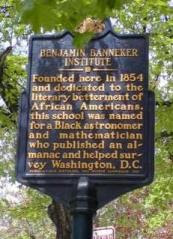 In honor of Black History Month.
In honor of Black History Month.In Philadelphia there are these series of historic markers that list where a famous institution had been or where someone well known had lived. This post is about one of those markers and who it is dedicated to. It was actually written a few years ago when I took a class for Web Development.
Since I had to create a web site, I chose to do one one on historic markers listing famous African Americans. One of the pages on that website was this. As in most classes you learn how to cheat a little bit without getting caught and I'm not really sure how much of it I actually wrote and how much is just a cut and paste job that I did, but here it is.
The Banneker Institute was named after Benjamin Banneker (1731-1806), he was probably the best-known African American in the early years following Independence. He was an astronomer, farmer, mathematician, and surveyor. In 1791, after being recommended by Secretary of State Thomas Jefferson, Banneker was an assistant to Major Andrew Ellicott, the surveyor appointed by President George Washington to lay out the boundaries of the District of Columbia.
Banneker was born near Baltimore a son of a slave and an indentured servant. His grandmother, an Englis
 hwoman, taught him to read and write. For several winters he would attend a small school open to blacks and whites. He developed an interest in mathematics and science. He pursued his mathematical studies after he became a farmer and taught himself astronomy. From 1791 to 1796, Banneker made all the astronomical and tide calculations and weather predictions for a yearly almanac.
hwoman, taught him to read and write. For several winters he would attend a small school open to blacks and whites. He developed an interest in mathematics and science. He pursued his mathematical studies after he became a farmer and taught himself astronomy. From 1791 to 1796, Banneker made all the astronomical and tide calculations and weather predictions for a yearly almanac.Banneker sent Jefferson a copy of his first almanac. With it he
 sent a letter calling for the abolition of slavery and a liberal attitude toward blacks. Banneker' s skills impressed Jefferson. Jefferson sent a copy of the almanac to the Royal Academy of Sciences in Paris as evidence of the talent of blacks. Opponents of slavery in the United States and England also used the almanacs as evidence of the abilities of black people. The publishers of Banneker's almanacs printed contributions by prominent Americans in addition to his material. In the 1793 almanac, for example, the surgeon and statesman Benjamin Rush proposed the appointment of a U.S. secretary of peace.
sent a letter calling for the abolition of slavery and a liberal attitude toward blacks. Banneker' s skills impressed Jefferson. Jefferson sent a copy of the almanac to the Royal Academy of Sciences in Paris as evidence of the talent of blacks. Opponents of slavery in the United States and England also used the almanacs as evidence of the abilities of black people. The publishers of Banneker's almanacs printed contributions by prominent Americans in addition to his material. In the 1793 almanac, for example, the surgeon and statesman Benjamin Rush proposed the appointment of a U.S. secretary of peace.The Banneker Institute is located at 409 S. 11th St, Philadelphia.
now he was brilliance personified
ReplyDeleteTorrance - Yes he was, all in his own, and I think quiet way.
ReplyDeleteWe have markers like that here in Baltimore, too. I walked past one ther other day and stopped to read it. Low and behold...I was walking on a street that George Washington marched on victoriously during the War of 1812 or something.
ReplyDeleteIts funny you mention Banneker being from Baltimore...I had no clue. Or perhaps I just forgot.
Thanks for these lil history lessons, btw.
Mr Jones - Strange how that works out huh? Sometimes there's history and significance right there in your back yard or even in your own family and you never realize it until one day you look up and it's there, where it always has been.
ReplyDelete